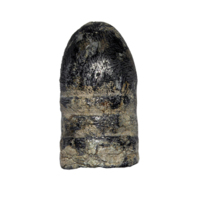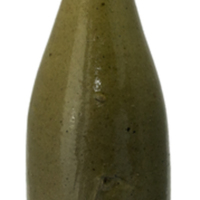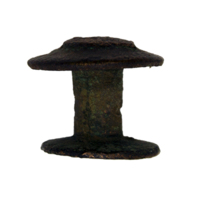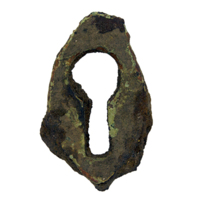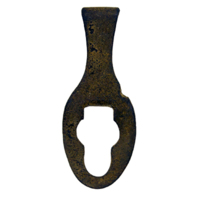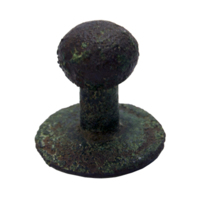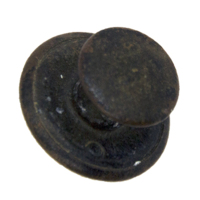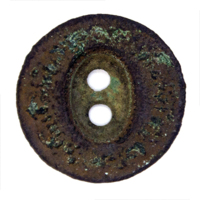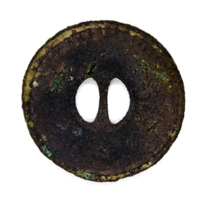The Smithfield Tragedy
Robert Craig and Bill Smith - The murder-suicide that shocked Smithfield.
Boxing Day, Thursday 26 December 1877.
Old Smithfield Township was named after 'Bill' Smith,1 a bushman and publican from Cooktown who found a pack track from the Hodgkinson goldfields down Bunda Djarruy Gimbul (the Lamb Range) to the Barron River. Smith, and his young Scottish wife Mary,2 opened the Pioneer Hotel on Macdonald Street in Smithfield.
Across the road from the Pioneer Hotel was Craig & Co.'s warehouse, receiving store and shop. Robert Jackson Craig3 of Brisbane had established stores in Cairns and Smithfield and was doing a roaring trade. He lived in Smithfield with his wife Mary and their three children.
On Boxing Day 1877, the townsfolk of Smithfield held a horse-race meeting. The event was well-attended, and Smithfield locals mixed with visitors from Cairns and the Hodgkinson, as well as a few people from Cooktown who came down on the mail steamer.4
After the race meeting, Smithfield was “thrown, into the wildest excitement and horror by the perpetration of … perhaps the most extraordinary and terrible event in the annals of Australian crime”.5 Smith had a booth at the Smithfield races selling liquor. It was well patronised, people drank heavily and the stock soon ran out.6 He asked Craig to supply him with more alcohol, but Smith’s account was overdue and Craig refused to supply him with any more stock until the debt was settled.7
At midday, Smith left the booth in charge of his wife Mary and returned home.8 Around 2.30 pm, Smith, who was under the influence of drink, entered Craig’s store and asked Craig to come over to his hotel where he would “settle with him”. Assuming that Smith intended to pay his account, Craig followed him across the road, but upon entering the hotel dining room Smith produced a revolver and fired twice, striking Craig once in the chest. Craig ran out onto Macdonald Street crying out “Murder, murder!”. Smith came out onto his hotel verandah and fired two more shots. Craig staggered across the street and onto the verandah outside his store. His brother-in-law, Bill Cochrane, who had been working inside at the grocery counter, ran outside, caught hold of Craig and laid him just inside the doorway of his store.9 Craig said “I am done, Bill; I have it in me” and in a few seconds he died.10
A woman who worked up the street at Henry Koch's 'American Hotel' was standing nearby. Smith turned to her and said “I’ve killed my wife, now I’ll kill myself”, and then he turned the revolver towards his chest and fired one shot.11 He dropped the firearm, grabbed his chest and collapsed. A packer named James Ferrier ran over to Smith, who looked up and said “Give me a drink of water, old fellow”, but when he was presented with a glass, Smith was unable to drink anything. The woman ran into the hotel to search for Smith's wife Mary, but found all the bedroom doors were locked and Mary was nowhere to be seen. Hearing the altercation, Constable James H. Norris, a police constable stationed at Smithfield, went out and found Smith with blood on his shirt, laid on his back on the verandah of his hotel. Smith stretched out his hand and said “Will anyone hold me up?”. With the assistance of another man they got him into a sitting position. After 15 minutes or so Smith said “Oh, I am done!” and he died.12 Ferrier found the revolver and handed it to Constable Norris who searched around the hotel dining room and found a single bullet.13
Cairns Police Magistrate William Matthew Mowbray and Police Inspector Thomas Clohesy arrived from the race meeting, and a messenger was sent to Cairns to get Dr. Edward Myers. Constable Michael McCormack, the officer in charge of the Smithfield police station arrived and inspected the deceased. Smith was lying inside his dining room with a bullet wound “on the right breast a little below the nipple”. It was a small hole, about three-eighths of an inch in diameter and there was very little blood.14 Craig was in Cochrane’s cottage. He had a bullet wound on the left breast about one inch from the centre of the chest and two inches below the left nipple. There was no exit wound and the bullet appeared lodged near his shoulder blade. There was also a mark on Craig’s right loin that looked like it had been grazed by a bullet.
The following day at Smithfield police station, police magistrate Mowbray held an inquiry into Craig’s death.15 Evidence was taken from Cochrane, Ferrier and Constables Norris and McCormack. Smith, who was around 52-years old and was recently married to a much younger wife, was found to have murdered Craig. Mowbray was unable to establish a motive for the murder-suicide, as “Craig and Smith always appeared to be very good friends” and no one knew of any disagreement between them.16
Smith had been in financial difficulty for some time and he owed money to several merchants.17 He had allegedly threatened a storekeeper when they asked him to settle his account – Smith told the storekeeper that he would “very soon show him a very sure way of settling it”.18 There were rumours around that on Boxing Day morning, the refusal of two storekeepers to supply him with spirits until he had liquidated his liabilities had been the cause of his crime. It was assumed that Craig was one of the two who had refused Smith and some even suggested that Craig had been pressuring Smith to pay his account.19 Smith had been suffering from ill-health and depression for many months, with some speculating he did not have long to live.20 Ten days earlier he told Norris he often considered committing suicide when he was travelling through the bush.21 There were several other witnesses who were not interviewed at the inquiry, but they confirmed that Smith was in the habit of drinking a good deal and had been drinking heavily on Boxing Day “as was his custom at the races” and so “there was very little doubt that his mind was deranged by drink”.22 No one seems to have thought to ask Smith’s widow for her thoughts on the matter.
Craig was 34-years old, had a pregnant wife, Mary, and three children who had left Cairns about three weeks earlier to go to Brisbane.23 His body was taken into Cairns on 27 December 1877 after the inquiry and he was buried in the new cemetery (now the McLeod Street Pioneer Cemetery).24 Cairns businesses were closed for the day and flags flew at half-mast. The funeral service was well attended and the eulogy was read by Clerk of Petty Sessions James Powers. The Cairns Advertiser & Smithfield Observer described Craig as a man “held in universal respect and was justly considered one of the leading men”.
The attendance at the funeral being very large, and without exception every house and business in town was closed. The funeral service was impressively read by Mr. James Powers. The awful catastrophe, so sudden, so unprovoked, and so very fatal, entirely unhinged everyone’s nerves. Business was at a complete standstill, and the sorrowful countenances met at every stop manifested the universal grief for the late Mr. Craig and sincere sympathy for his family.25
Smith’s interment was much less remarkable. He was buried on 27 December 1877 in an unmarked grave near the Smithfield township, the location of which is unknown. The milkman, Louis Kopp, dug the grave and Storch and Martin were the witnesses.26 Presumably widow Mary was there as well. The Cairns Advertiser & Smithfield Observer pondered that “the unhappy murderer’s fate can but likewise cause a sorrowful feeling”.
Smith was a man known by and to all of us. We all are cognisant of recent troubles and misfortunes which overtook him, and, although we cannot conceal from ourselves that those troubles have been sensibly brought about by his own passions and irregular conduct, still a thought of Christian and human regret must flash through our brain, knowing this man took his own life at the moment he took that of another, and was hailed into the presence of his Maker without time to implore divine forgiveness for the cruel and cowardly murder he had committed.27
A short time later, when one of Craig’s Polynesian employees heard of his death, “the Kanaka possessed himself of a double-barrelled gun, and went straight to Smith’s house, with the intention of shooting him dead, not being aware that the murderer had committed suicide”.
On learning that Smith was dead, he went in pursuit of Mrs. Smith, whose death, according to his light, would be a vicarious sacrifice, and expiate in some measure her husband’s crime. Fortunately his intentions were discovered in time to prevent another death, for nothing is more certain than that had he met Mrs. Smith, when the passions of grief and anger were contending for the man, the latter would have obtained sway, and he would have shot her.28
After this incident, “the faithful fellow” mounted a vigil at the cemetery and for some days “he could not be persuaded to eat or drink, nor to leave his sad watch over Craig’s grave”.
The event unhinged everyone’s nerves in the township.29 The “appalling murder and suicide at Smithfield” became national news and was reported widely in the press, with just about every Queensland newspaper carrying the story, as well a host of inter-colonial papers in capital cities and regional centres in New South Wales, Victoria, Tasmania and South Australia.30 The news was even widely reported in Scotland, Craig’s birthplace.31 The widespread coverage and the horror at the “Great Tragedy at Cairns” shows that sensational events like this were rare and that Smithfield was not a “sink of iniquity” and did not have a reputation for violence and murder. Craig & Co. went into liquidation and Cairns forwarding agent, Thomas Mill Latreille, was appointed trustee. Robert and Mary Craig’s sixth child, William Cairns Cathcart Craig, was born in South Brisbane on 28 July 1878, seven months after Craig’s death.32
A dispute arose over the ownership of the murder weapon when McCormack informed Isley that Norris still had Smith’s revolver in his possession and would not return it to Smith’s widow.33 Robert H. O’Donnell, who with Tom Pickett ran the Leichhardt Hotel in Abbott Street in Cairns, also claimed ownership of the revolver and McCormack thought that there would eventually be questions asked about the whereabouts of the murder weapon. There is no record of who finally took possession of the revolver.
There was another sad footnote to the story. Mary Smith, 28-years old and now widowed twice, moved to the Hodgkinson goldfield and married Robert Miles Shaw in 1880.34 Their relationship was not a happy one and in 1882 Shaw moved to Townsville and Mary moved to Cloncurry, where she assumed a new identity and was known as ‘Mrs. Jones’. She had a house near the Grand Hotel on the copper-mine road and was known to drink heavily.35 On 17 October 1886, at the age of 36, Mary committed suicide by drinking strychnine.36 She was buried in an unmarked grave at Cloncurry Cemetery.37
| Inquest into the death of: Robert Jackson Craig & William Smith (Inquest ID: 348655, 1877, Queensland State Archives). Read the inquest ⇒ HERE. |
|
 |
This webpage is an excerpt from the upcoming book Old Smithfield: Barron River township (1876-1879) by Dr Dave Phoenix. Find Out More Here |
Featured Artefacts from Old Smithfield:
-
1. William ‘Bill’ Smith
(c.1826/1833, Hertfordshire–1877, Smithfield). ↩ -
2. Bill Smith’s wife was Mary McKee (1847, Glasgow–1886, Cloncurry), daughter of Joseph McKee and Mary Ann Beattie.
Mary married three times,
- firstly Mr. Edwards,
- then as ‘Widow Edwards’ she married Bill Smith in Cooktown on 17 February 1875 (Queensland marriage certificate 1875/C71),
- and finally she married Robert Miles Shaw (1853?–1915) at the Hodgkinson (Queensland marriage certificate 1880/C824). ↩ -
3. Robert Jackson Craig (1844, Lanarkshire–1877, Smithfield), married Mary Ann Stenson Cochrane (c.1847, Dundee–1893, Brisbane) in Brisbane, (Queensland marriage certificate 1865/B1448),
and had six children, four of whom were alive at the time of Craig’s murder: Elizabeth, Robert Jackson, Frederick William and William Thomas. Mary was pregnant when Craig was murdered and gave birth to William Cairns Cathcart Craig in July 1878. ↩ -
4. Hodgkinson Mining News, 2 [sic 5] January 1878: 2,
D2108, Cairns Historical Society. ↩ -
5. Brisbane Courier, 7 January 1878: 3 printing an abridged version of an article in the Cairns Advertiser & Smithfield Observer. ↩
-
6. Cooktown Courier, 29 December 1877: 3. ↩
-
7. Robert Jackson Craig (1844, Lanarkshire–1877, Smithfield), married Mary Ann Stenson Cochrane (c.1847, Dundee–1893, Brisbane) in Brisbane, Queensland marriage certificate 1865/B1448, and had six children, four of whom were alive at the time of Craig’s murder: Elizabeth, Robert Jackson, Frederick William and William Thomas. Mary was pregnant when Craig was murdered and gave birth to William Cairns Cathcart Craig in July 1878. ↩
-
8. Hodgkinson Mining News, 2 [sic 5] January 1878: 2,
D2108, Cairns Historical Society. ↩ -
9. Brisbane Courier, 7 January 1878: 3. ↩
-
10. Robert Jackson Craig,
Queensland death certificate 1877/C377. ↩ -
11. Hodgkinson Mining News, 2 [sic 5] January 1878: 2, D2108, Cairns Historical Society. ↩
-
12. William Smith,
Queensland death certificate 1877/C359 ↩ -
13. Brisbane Courier, 7 January 1878: 3. ↩
-
14. Australian Town and Country Journal, 12 January 1878: 13. ↩
-
15. Police Magistrate William Matthew Mowbray,
Magisterial Inquiry, Police Office, Smithfield, 27 December 1877,
D35, Cairns Historical Society. ↩ -
16. Brisbane Courier, 7 January 1878: 3. ↩
-
17. Hodgkinson Mining News, 17 March 1877: 3,
D2108, Cairns Historical Society. ↩ -
18. Hodgkinson Mining News, 2 [sic 5] January 1878: 2, D2108, Cairns Historical Society. ↩
-
19. Daily Northern Argus (Rockhampton) 1 January 1878: 2, reprinting an article from the Cooktown Courier; Telegraph (Brisbane), 29 December 1877: 2. ↩
-
20. Hodgkinson Mining News, 17 March 1877: 3,
D2108, Cairns Historical Society. ↩ -
21. William Matthew Mowbray, Magisterial inquiry, Police Office, Smithfield, 27 December 1877, see: Australian Town and Country Journal, 12 January 1878: 13. ↩
-
22. Hodgkinson Mining News, 17 March 1877: 3,
D2108, Cairns Historical Society. ↩ -
23. Mary Anne Stenson Cochrane (c.1847, Dundee–1893, Brisbane), married Craig in Brisbane in 1865. Robert and Mary had six children; Ada Elizabeth, Robert Jackson Jnr, Frederick William, Alfred William Thomas, William Thomas, and William Cairns Cathcart, four of whom were alive at the time of Craig’s death. ↩
-
24. Dorothy Jones in Trinity Phoenix thought Craig may have been buried in the original Cairns cemetery on the Esplanade, but the new cemetery had already been proclaimed and Craig was one of the Trustees, so it is more likely that he was buried in the new cemetery, see: Jones, Trinity Phoenix, 123-124. Robert Jackson Craig had been appointed one of the trustees of the new Cairns cemetery in October 1877. ↩
-
25. Brisbane Courier, 7 January 1878: 3. ↩
-
26. Alfred John Martin, see Cairns Post, 25 August 1919: 4. ↩
-
27. Murdoch Wales, ‘Old Bill of Smithfield’, 1971,
D447, Cairns Historical Society. ↩ -
28. Mackay Mercury and South Kennedy Advertiser, 13 February 1878: 3. ↩
-
29. Brisbane Courier, 7 January 1878: 3. ↩
-
30. The news of the murder-suicide was reported in Queensland colonial papers the Queenslander and The Week (Brisbane); Brisbane papers Brisbane Courier Telegraph; and regional papers like the Cairns Advertiser & Smithfield Observer, Cooktown Courier, Maryborough Chronicle, Wide Bay and Burnett Advertiser, Morning Bulletin (Rockhampton), Capricornian (Rockhampton), Daily Northern Argus (Rockhampton), Darling Downs Gazette and General Advertiser (Toowoomba), Toowoomba Chronicle and Darling Downs General Advertiser and Warwick Examiner and Times. Inter-colonially, the news was widely reported in capital cities and regional towns, and widely reported in gold mining towns, for example, see: The Advocate, The Argus and The Australasian (Melbourne), The Sydney Morning Herald, Australian Town and Country Journal and Evening News (Sydney), South Australian Register, South Australian Advertiser, South Australian Chronicle and Weekly Mail , Evening Journal and The Express and Telegraph (Adelaide), Launceston Examiner, The Mercury and Tribune (Hobart), as well as The Bendigo Advertiser, Geelong Advertiser, Mount Alexander Mail, Ballarat Star, Kyneton Observer, McIvor Times and Rodney Advertiser, The Goulburn Herald and Chronicle, etc. ↩
-
31. A Lanarkshire Gentleman Murdered in Queensland’ was reported in the Edinburgh Evening News, Glasgow Herald, Greenock Advertiser, 30 March 1878; Aberdeen People’s Journal, 6 April 1878. ↩
-
32. Thomas Mill Latreille (c. 1844, London–1882, Cairns), married Elizabeth Beazley in Brisbane in 1870 and had six children. William Cairns Cathcart Craig (28 July 1878, South Brisbane–27 September 1878, South Brisbane). ↩
-
33. Statement from Constable M. McCormack, dated Police Station Cairns, 29 January 1878, C.12/1878. ↩
-
34. Widow Mary Smith married Robert Miles Shaw (1853?–1915) at the Hodgkinson (Queensland marriage certificate 1880/C824). ↩
-
35. Evening News (Sydney), 20 October 1886: 6; Queenslander, 23 October 1886: 645. ↩
-
36. Mary Shaw was found dead in her bed at 7.00 p.m. on 17 October 1886.
A post-mortem examination was carried out that evening and Sergeant of Police John Hamilton conducted an inquiry the next day.
See: Inquest ID: 348735 (JUS/N136), Queensland State Archives. ↩ -
37. Mary was buried at Cloncurry Cemetery on 18 October 1886.
(Queensland death certificate 1886/C984). ↩


